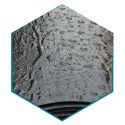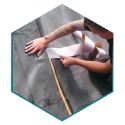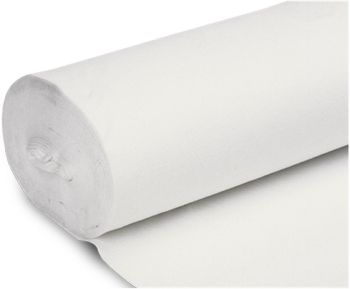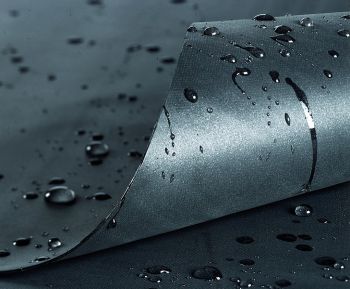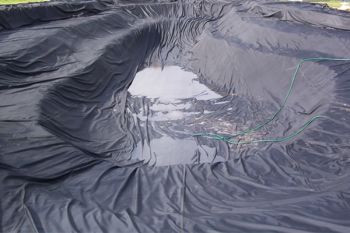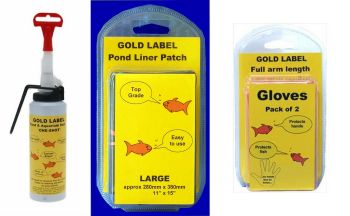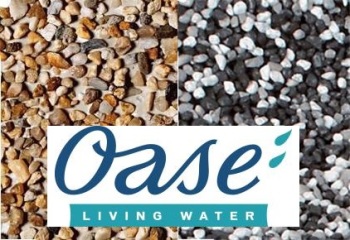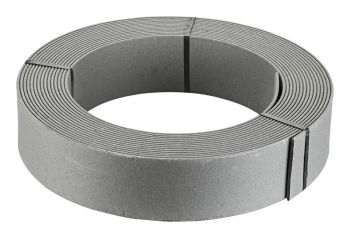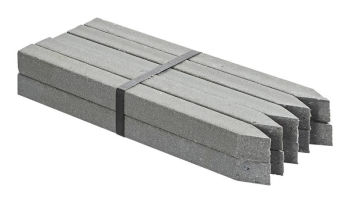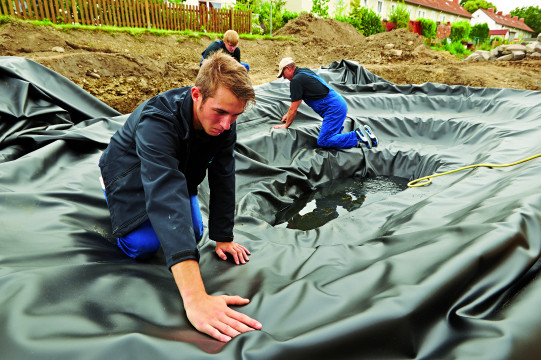
Installing a pond liner can be a very simple task, or a more complicated endeavour, depending on the scale of the pond and the complexity of the pond design. In this article, we cover how to line a pond fexible lining materials, and how to fit rigid preformed pond liners. We explain how to build a pond with a liner, how to install a pond liner and identify some of the more common obstacles involved with installing a pond liner and how these can be overcome.
Types Of Pond Liners: What Pond Liner Do I Have?

Flexible
A flexible pond liner, as the name suggests, is a sheet of pond lining material that is not rigid in build or form, but rather a thin, pliable membrane that can be sculpted to fit the internal shape of a pond. A flexible pond liner will usually come in the form of a square or rectangular sheet, folded or rolled up in a package for ease of storage and transportation. Flexible pond liners are available to buy pre-packaged in a wide range of sizes to suit many different pond lining applications. Longer, narrower rolls of flexible liner are available for streamlining, and custom-made welded flexible liners can be produced in box or cylinder form for more formal square, rectangular or circular ponds.
Installing a flexible pond liner essentially involves unfurling the pond liner into its open form and laying this neatly into the structure or excavation you have prepared for your pond. How to install a flexible pond liner depends on the type of flexible pond liner you have, and the type of pond being lined. The most common application for a flexible pond liner would be a sunken or recessed pond, dug into the ground by excavating a hole in the soil and lining it with a flat sheet liner.
Raised or structural ponds that have been constructed rather than dug out can also be lined with a flexible pond liner. Installing a flexible pond liner into a structural or raised pond follows much of the same installation techniques, but will often better suit a custom-built flexible pond liner in box or cylinder form, as these ponds tend to be more formal in shape and can look untidy when lined with a flexible sheet liner.

Rigid
A rigid pond liner is more commonly referred to as a preformed pond. As the name suggests, this type of pond lining is simply a rigid pond, formed from plastic in a mould, of a set size and shape. Rigid pond liners can be rectangular, or of a more ununiform shape that represents a natural pond, with deep sections and shallower marginal shelves. Recessing the pond into the ground is essentially how to install a rigid pond liner, as these types of pond liners require the ground around the pond to provide structural support, and therefore cannot be installed as raised ponds above ground.
Preformed ponds are generally plastic or fibreglass in composition. Although these pond liners are considered to be among the easiest to install, these are limited by set sizes and shapes, which do restrict what can be created. Rigid pond liners are also more difficult to transport than flexible pond liners.
Installing a preformed pond requires a hole to be excavated from the soil to a size exceeding the dimensions of the preformed pond you are installing so that the rigid pond liner can be placed into the excavated hole and backfilled. When installing preformed pond products, it is important that the base of the excavated hole is flat and level, so that the rigid pond liner remains stable and supported with a level water surface.
Sand should be used to level and compact the base of the soil-dug hole before you install a rigid pond liner, and any gaps between the edge of the hole and the edge of the liner need to be backfilled with compacted sand or soil, right up to the preformed pond edge. This backfilling ensures that the rigid pond liner is supported around the outer wall, and maintains shape and structural rigidity when water is added.
Does Pond Liner Need To Be One Piece?
Essentially, yes, the finished, installed pond liner does need to be one piece in order to ensure all of the water is retained in the pond, but the pond liner does not necessarily need to be purchased in one piece. Rigid pond liners and preformed ponds will almost always be supplied in a single piece. Flexible pond liners, however, can be joined together with seaming materials to create larger sheets or irregularly shaped liners. A pond liner should be supplied and fitted in one piece if the pond in question can be completely lined with one piece of material. Prefabricated one-piece liners are ideal, as all of the necessary seams, welds and joints have already been professionally produced in the factory, meaning no joining of material is required during installation. Installing a premade, single sheet of material is also easier and more failsafe than seaming sections of pond liner material together during installation, so a prefabricated one-piece pond liner is generally preferred wherever possible. Most small to medium-sized ponds can be lined using a liner that is supplied and installed in one piece. With that said, there are scenarios where one piece of liner is just not practical, such examples include ponds that are simply too large to line with one piece of liner, or ponds that feature long, narrow streams or intersections. These ponds may require both broader sheets of material, and narrower rolls in order to line the pond most efficiently, with minimal wasted liner material. In these cases, multiple pieces of liner material can be obtained, along with seaming tapes, adhesives and priming components to join sections of pond liner together.
Pond Sizes: What Size Pond Liners
Small
A small pond can be anything from a large puddle, up to a size of around 20 square metres. Small ponds are often found in private back gardens and are usually the pond of choice for first-time pond owners, and those just dipping their toe into the pastime of pond keeping for the first time. Small ponds are easy to manage and maintain due to the limited volume of water contained in the pond. A small pond can be lined with a flexible pond liner, or a rigid pond liner.
Unless you are using a rigid pond liner of a prebuilt size, the size of a liner you would use for a small pond could only be known after the pond hole has been excavated and measured in order to size the liner correctly.
An example of a small pond might be a pond of around 2 metres long and 3 metres wide, with a deepest depth of 600mm. This pond would require a flexible pond liner in the area of 5 metres long and 4 metres wide.
Medium
A medium pond could be anywhere between 20 and 50 square metres. Medium ponds will usually require a flexible pond liner, supplied as a single sheet, as these ponds tend to be too large to be lined with rigid preformed pond liners. Although medium ponds can be lined with a single piece of flexible pond liner, the liner may be heavy and require more than one person to assist with transporting the liner, unfurling, and manoeuvring the flexible liner into position.
An example of a medium pond might be a pond of around 7 metres long and 5 metres wide, with a deepest depth of 1500mm. A flexible pond liner of around 11 metres long and 9 metres wide would be an appropriate size for a pond such as this.
Large
A large pond is a pond which exceeds 50 square metres in surface area. As with medium ponds, a large pond can sometimes be lined with a flexible pond liner supplied in a single piece, but often will be of a size that makes lining with a single sheet of material unviable. When a large pond is too large to be lined with one piece of material, multiple pieces of liner may be required, and these sheets would be seamed together onsite during the lining process.
A large pond of 20 metres long and 15 metres wide at a depth of 2.5 metres might be lined with a flexible sheet liner somewhere in the area of 27 metres by 22 metres.
A very large pond of say, 50 metres by 70 metres surface area would be beyond the scope of a single piece sheet liner. This is a scenario whereby two of more sheets of material would be obtained and seamed together as part of the installation.
Pond Liner Materials: What Is My Pond Liner Made From?
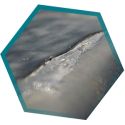
Rubber
Rubber is a well-established pond lining material, although most of the modern pond liners marketed as rubber today will not be formed from natural rubber, but rather a synthetic rubber product such as EPDM rubber. This is because natural rubber is not resistant enough to UV rays for permanent outdoor installation and can become brittle and fail over time, whereas EPDM is more resistant to UV and therefore makes for a much more reliable pond liner. EPDM has all of the recognisable characteristics of truly natural rubber in a synthetic form. How to install a rubber pond liner is no different to installing any other flexible sheet liner, and essentially follows the same processes of excavation, ground preparation and liner installation.
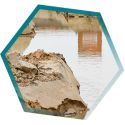
Clay
Ponds can be successfully made watertight using clay rather than using a premade pond lining membrane. How to install a clay liner in a pond involves an old traditional technique known as puddling, whereby clay is placed into a pond excavation and manually compacted down to remove all of the air trapped in the clay, with the resulting compact clay forming an impermeable barrier between the soil and the water. This is a very natural and environmentally friendly way to create a pond. However, unlike an artificial pond liner, when using clay, you are effectively building the pond liner yourself, so the quality of the workmanship can be key to success or failure when using this method, whereas a premade pond liner is guaranteed to hold water. Building ponds using the clay puddling lining technique is a labour-intensive process and success is not guaranteed if attempting this yourself. Clay puddling is best carried out with a team of people working together, rather than taking this on as an individual. The layer of compacted clay required to create a watertight barrier needs to be relatively thick, a minimum depth of 300mm is suggested, so the pond excavation hole needs to be dug down deeper to allow for the clay base as well as the depth of water. The amount of clay required to successfully line a pond can be considerable, and it helps if the ground being excavated contains a natural level of clay. Most garden ponds will not be clay-lined ponds and would instead be lined with a rigid or flexible pond liner, which is the more standard method of pond lining.
PVC
PVC is considered to be a cheaper material for pond lining, and is generally thinner and less resistant to wear than other materials on the market, but can still be a very reliable membrane if used within its limitations, and safeguarded with a heavy-duty protective underlay. 0.5mm thick PVC is the standard specification for lining small ponds. 0.8mm PVC can be supplied for larger projects. PVC is a smooth, stiffer, material that is somewhat pliable, but with virtually no stretchability, it can be less forgiving when pleating or folding into corners or negotiating marginal shelves.
The advantages of using a PVC liner are:
- PVC is generally less costly than other, more premium lining materials.
- PVC is a lighter material and requires less physical strength to move.
- PVC is widely available to purchase as either prepacked liners, or cut from the roll.
The disadvantages of using a PVC liner are:
- PVC liners cannot stretch, which makes the material less conforming to shape.
- PVC is not as flexible as EPDM or Butyl and can be more difficult to work with.
- PVC is a thinner lining material and is therefore more likely to be punctured.
- PVC can be notoriously difficult to join, glue or repair if damaged.
HDPE
HDPE is a relatively stiff, yet still somewhat flexible material which is sometimes used for lining ponds, among other applications, such as being used in the manufacture of pipework. A typical HDPE pond liner might be around 0.30mm thick, although this material is also used commercially for applications such as lining on landfill sites (in significantly thicker grades) due to its chemically resistant properties. HDPE is not the best material to use for pond lining, as it lacks the pliability of other materials such as Butyl and EPDM, and should generally be reserved for pond lining applications where minimal pleating is required and if budget restraints are a limiting factor in the pond construction.
The advantages of using a HDPE liner are:
- HDPE is one of the cheapest materials available that can be used to line ponds.
- HDPE pond liners are widely available.
The disadvantages of using a HDPE liner are:
- HDPE is a stiffer material which is less forgiving when pleating and folding the sheet.
- HDPE pond liners are thinner than many other materials used to line ponds.
- HDPE has no stretching properties, which limits shaping and can look untidy.
Butyl
Butyl, or Butyl Rubber is considered to be a premium pond lining material, usually available in sheet and roll form in 0.75mm and 1.00mm grades of thickness. As well as being used to line ponds, Butyl is recognised within many industries as being a robust, reliable construction material. Such is the versatility of the product, Butyl is used in the fuel industry as an additive, in the manufacture of goods including vehicle tires, in the roofing industry, in window insulation and many other applications. Butyl has all of the characteristics a high quality pond liner requires, but Butyl is a very sought after material, which can limit availability in the pond industry and increasing demand for it makes the product an expensive option when compared with other flexible pond lining materials.
The advantages of using a Butyl pond liner are:
- Butyl is very robust and offers excellent puncture and wear resistance.
- Butyl is a very stretchy and pliable material which conforms well to pond contours.
- Butyl is recognised in the building industry as a high quality construction material.
- Butyl carries a long guarantee and some producers will even offer a lifetime warranty.
- Butyl is a material that is easy to repair with bonding adhesives and patches.
The disadvantages of using a Butyl pond liner are:
- Butyl is one of the most expensive pond lining material on the market.
- Butyl can be hard to find. It is used in many industries, so demand can exceed supply.
EPDM
EPDM is a very popular flexible liner material, and is probably the most used material for pond lining on the market today. EPDM is favoured due to its excellent material characteristics, and cost when compared with the very similar material Butyl. EPDM is suitable for lining ponds of all sizes, and there are a number of EPDM brands on the market, offering sheets of EPDM pond liner in 0.75mm and 1.00mm grades of thickness. EPDM brands such as SealEco’s GreenSeal product are also renowned for being very environmentally friendly in both processing and composition. EPDM is an easy material to work with and conforms very well to pond contours. It is also a material that can be joined, welded, seamed and repaired very effectively. As well as sheet liners, custom box welded and circular welded liners can also be produced and supplied in EPDM.
The advantages of using an EPDM liner are:
- EPDM is one of the most durable materials that can be used for pond lining.
- EPDM is very resistant to UV rays and should not deteriorate in sunlight.
- EPDM is an extremely malleable material with good stretching properties.
- EPDM is an environmentally friendly and sustainable material.
- EPDM is in good supply and premade liners are widely available to purchase.
- EPDM joins very well with tapes and glues and is easy to repair if punctured.
The disadvantage of using an EPDM liner are:
- EPDM tends to be in the midrange pricewise and so doesn’t cater to all budgets.
How Thick Does A Pond Liner Need To Be?
A pond liner does not necessarily need to be thick to be reliable. A relatively thin pond liner can be perfectly adequate for lining a pond, provided the material used is durable enough to withstand the elements. Most ponds can be adequately lined using a liner of 0.5mm thick to 1.00mm thick, provided a protective underlay is used to shield the membrane from puncture. As a basic rule of thumb, the larger the pond is, the thicker the liner should be, as more surface area and water volume puts more demand on the liner. Material and thickness also go hand in hand, for example, small garden ponds may be lined using a PVC liner, which is typically available from 0.5mm thick to 0.8mm thick. Larger ponds would tend to be lined using Butyl or EPDM materials, which are usually produced at 0.75mm thick to 1.00mm thick. Liners exceeding 1.00mm thickness would generally only be seen in water reservoirs and industrial applications. Smaller ponds can still be lined with thicker materials for added peace of mind, but the most important thing is to use a puncture resistant protective underlay too, regardless of pond liner material or thickness.
What Is The Lifespan Of A Pond Liner?
If the right material for the job is selected and the pond liner installed correctly, the lifespan of a pond liner could be 30 years, or even longer. The lifespan of a PVC liner might be somewhat more limited, due to this material being generally thinner, and not having the required flexibility or elasticity to adjust with earth movement. A lifespan of 20 years for a PVC liner would be considered high, but certainly modern Butyl and EPDM liners are expected to last well over 20 years if installed correctly and adequately safeguarded. Modern pond liners are UV stable, weather resistant and non-biodegradable, ensuring longevity. Ultimately, the lining material should last forever, which is why many liners are sold with a lifetime guarantee. With that said, the lifespan of an installed pond liner can depend on a number of factors, such as the standard of the installation, the correct lining materials being used, and how the environmental and terrestrial conditions change over time. There are basic installation practices that should be followed if the liner is to have an elongated lifespan. If the pond liner is adequately protected from beneath with a barrier of puncture resistant underlay, the lifespan of a pond liner will be maximised, as plant roots and objects in the ground will be redirected away from the membrane as the earth moves with time. Although modern pond lining materials are very durable, there is always the possibility of a pond liner being punctured from above, regardless what material is used, as the top side of the liner is often left exposed, with no overlay barrier. Selecting a lining material such as EPDM, that is very easy to repair in the unlikely event of a puncture, should ensure decades of service life from your pond liner.
What You’ll Need To Line Your Pond
Materials:
Pond Liner
Protective Underlay
Sand
Weights (Bricks/Slabs/Rocks)
Capping Stones
Tools:
Shovel
Pitchfork
Rake
Wheelbarrow
String or Rope
Spirit Level
Box Cutter Knife or Sharp Scissors

Pond Liner Installation: How To Fit Your Liner
Do You Need Sand Under A Pond Liner?
You do need sand under a pond liner if the earth beneath the pond liner is uneven in consistency, or contains sharp items that put the pond liner at risk of puncture. A layer of sand around 2” deep between the soil and the pond liner will help to level the ground at the base of the pond, and puts a smoother physical barrier between the rough ground and the pond liner. The sand in the base of the hole can be pressed and compacted down to give the pond floor a stable and even topography before the pond liner is installed. Sand is also very useful for backfilling if a preformed pond or rigid pond liner is installed, as sand can be poured into gaps and fill voids that would otherwise weaken the structure of a rigid pond liner. If your pond features a flat concrete base, sand may not be required. In any case, if using a flexible pond liner, a protective barrier of pond underlay also be installed to provide a softer cushion between the pond liner and the soil and/or construction materials.
What Do You Put Under A Pond Liner?
Before you install a flexible pond liner, you must put a protective layer of puncture-resistant underlay down. Pond underlay is a synthetic, matted geotextile product designed to create a barrier that is difficult to penetrate, which acts to redirect plant roots and safeguard the pond liner against sharp objects in the soil beneath the pond. A quality puncture-resistant protective underlay should cover all of the internal areas of the pond, ensuring that the rolls of material overlap to prevent roots from being able to pass through the underlay. When the underlay is in place, it is then time to install the flexible pond liner.
Which Side Of A Pond Liner Goes Up?
There is usually no difference between the two sides of a flexible pond liner, and it really does not matter which side of a pond liner goes up, it can be installed on either side without any issue. If one side of a flexible pond liner appears to look a little different or appears to be shinier than the other side, it is likely a result of the manufacturing process rather than a technical difference between the two sides of the pond liner, as the material used to formulate the sheet should be consistent throughout. It therefore shouldn’t matter whether you put the pond liner's shiny side up or down. Many flexible pond liners will not have a side that is noticeably different to the other side, other than perhaps some manufacturer branding being printed on only one side. Where branding is present on one side of a pond liner, the liner should be installed branded side down so that the brand logo is not visible when installed.
How Do You Weigh Down A Pond Liner?
You do not need to weigh down a pond liner, the water will provide all of the weight required to keep the liner pinned down tightly to the contours of the pond. You do however need to place temporary weights around the edge of a flexible pond liner when filling the pond with water. This limits the pond liner movement as the water pulls the liner inward, ensuring a more gradual and even adjustment of the liner position. If no weights are used at this stage, the liner may pull too far, or too quickly into the pond hole, which will render the installation a failed attempt and you will need to start again. Any heavy objects can be used as temporary weights, paving slabs are a popular choice as these are heavy and have a good surface area for stability. A number of weights positioned at intervals around the pond liner edge should ensure a more controlled pond filling process.
How Do You Get Wrinkles Out Of A Pond Liner?
How to get wrinkles out of pond liner is tricky. Wrinkles are somewhat inevitable, as a flat sheet of flexible pond lining material cannot be sculpted into the contours of a hole with some wrinkling. The more complex the shape of the pond is, the more wrinkles the installed pond liner is likely to have, so the best way of minimising wrinkles in the liner is to keep the pond design simple. Choosing a material such as 0.75mm thick EPDM, which is very malleable, will ensure that the pond liner conforms better to the pond contours than a stiffer material, and letting the liner heat up a little in the sunshine prior to fitting it will make the liner all the more pliable. Filling the pond up with water very slowly will allow noticeable wrinkles to be flattened and worked out of the liner at stages during the filling process, but there will always be a few wrinkles left in the liner when all said and done.
Measure Out The Pond Hole
Before a liner can be purchased, you must measure out the pond hole. This should be done by identifying the location of your pond, deciding how much ground area you are prepared to use, and sketching the outline perimeter of the pond onto the ground using chalk or powder to produce an outline on the ground. From there, you can excavate the hole, digging out any marginal shelves, steps and deeper areas you wish to incorporate. When the hole is completely excavated, accurate measurements can be taken in order to size your pond liner correctly. String is a very useful measuring tool, as this can be run from the bankside, following the contours of the pond along the longest point, right the way up to the opposite bank. The length of the string can then be marked, straightened and measured, with that measurement being the length that the pond liner needs to be. This process should also be done a second time, this time following the contours of widest width of the pond, with this measurement being the other measurement required to then be able to source an appropriately sized sheet of pond liner. When measuring with string, an allowance should be made for the liner pulling into the pond somewhat as the water pushes the flexible pond liner tightly into the pond contours. Therefore, the piece of string should begin at least a foot away from the pond edge, and finish up at least a foot beyond the far edge. If the pond is larger, the amount of excess liner allowance should be increased accordingly, with the largest of ponds allowing up to 3 feet of extra liner around the pond edge.
To install a flexible pond liner in a soil dug pond, you must first prepare the ground for the liner to be positioned. The ground should be levelled any visible objects in the soil that may come into contact with the pond liner should be removed. Compacted sand can be used to form an even base for the pond, and this also provides an additional layer of smoother substrate between the pond liner and the soil, helping to ensure that the liner is not being exposed to sharp objects in the soil. A couple of inches depth of sand in the base of the pond is adequate.
Classifying ponds by size can be a subjective topic, but most ponds can be broadly placed into one of three categories, these being small ponds, medium ponds and large ponds. Many of the typical pond lining practices can be applied to ponds of all sizes, although there are some factors to be considered when sizing your pond.
Small Ponds
How to install a small pond liner will depend on the particular liner being used to line the pond. Small ponds can be lined with a preformed pond, also known as a rigid pond liner, or with a flexible pond liner. Installation essentially involves digging a sizeable hole and laying or placing the pond liner, with a layer of sand and protective underlay put down first to prevent the pond liner being punctured. A small pond liner is the easiest pond liner to install, as the smaller size and weight of a small pond liner makes for lighter work, and the pond liner can usually be installed relatively quickly by a single person.
Medium Ponds
Medium ponds will always tend to be lined with a single piece flexible pond liner. The process of lining a medium pond is much the same as lining a small pond with a flexible pond liner, but with the lining materials scaled up for a bigger job. Medium ponds can be lined by a single person, or may require the assistance of a second person to assist with moving the larger, heavier liner into position.
Large Ponds
How to install a pond liner in a large pond depends on whether you will be using a single piece pond liner, or seaming sheets of material onsite to produce a larger liner. If a single piece of material is being used, the process of lining the pond is much the same as lining small and medium ponds with a flexible pond liner, just on a larger scale, with an additional allowance for excess material and with more personnel to assist with the installation of the larger sheet liner. If the large pond is being lined with more than one sheet of liner, onsite seaming will be required. Although the required seaming components can be obtained and used by anyone, an inexperienced individual should probably seek the services of a professional seamer, as mistakes can be very expensive, especially with larger ponds.
What Is The Best Glue For Pond Liner?
Should you need to glue or join your pond liner, you will need to obtain a glue that is compatible with the lining materials you are using. For Butyl and EDPM, there are glueing tapes and priming products that can be used together to apply patches and create seams. These materials also react well to liner bonding adhesive and waterproof sealants. Products such as Firestone QuickPrime and QuickSeam work well with these materials. PVC can be especially difficult to glue as the surface of a PVC liner tends to be very smooth and without texture, and cannot be primed. A PVC/Vinyl specific adhesive should be used for working with this material. Generic household glue brands are not appropriate for glueing pond liners, only a professional bonding adhesives and tapes for pond liners should be used.
How Do You Seal Seams In A Pond Liner?
The professional way to seam a pond liner is to use a glue tape or seaming tape with the appropriate primer. The primer prepares the material for bonding to the seaming tape and is applied to both of the pieces of liner being seamed. Once the primer has gone tacky, the seaming tape is then carefully rolled out along the seam length, being sure to keep this flat and without any air pockets forming between the tape and the pond liner. A roller can be used at this stage to roll out any bumps in the seam. The backing is then removed to expose the sticky upside. The second section of pond liner is folded over the top of the seaming tape so that the tape seam is between the sheets of pond liner. Again, a roller can be used to iron out the top side of the seam.
Shapes
Square Ponds
Square and rectangular ponds can be recessed ponds, partially raised or raised ponds. However, square ponds are normally solid constructions, built using building materials rather than simply being excavated and lined like a pond with a more variable shape would be. Building square ponds as a solid structure allows for neater shaping, and provides good structural strength, which is important as square ponds tend to have vertical pond walls rather than sloping sides. Square ponds can be of one consistent depth, or consist of a deeper area with shallower steps or shelves. Square ponds can be lined with a flat sheet of flexible pond liner, however, this is not always the neatest way to line this type of pond due to the the presence of corners in the structure, into which the liner must be pleated and folded. A custom built flexible box welded liner is a much neater way of lining square and rectangular ponds, as the box shaped pond liner is built precisely to fit the internal dimensions of the pond, which eliminates the need to do any pleating or folding in order to fit the liner. A box welded liner is a more costly solution when compared with sheet lining, but the reduced physical labour and a neater finish can be well worth the higher cost.
Round Ponds
Round ponds, just like square ponds, are constructed ponds with a solid floor and a vertical wall. These too can be recessed at ground level, or raised. Flexible sheet lining a circular pond, although possible, does not make for a very neat finish, and would usually not be considered for this style of pond. For this type of pond, a custom-made flexible welded liner with a circular floor and circumference wall can be produced to line the pond very neatly. Circular welded pond liners can be manufactured as straight walled cylinder shapes or made with a shallower marginal shelf and a deeper central area. A circular welded liner is built with excess material around the open top circumference which allows for the liner to be turned over at the top and secured with capping stones to finish the pond neatly and fix the pond liner in place.
Raised Ponds
Raised ponds are structural ponds that stand above ground level, or, in the case of partially raised ponds, some of the ponds stands above ground, with some of the pond below ground. Raised ponds tend to be more formal in shape, and consistent in depth. The reason for this is, being physically constructed ponds, geometrical shapes are the simplest structures to build with standard building materials such as bricks and blockwork, whereas sunken, soil-dug ponds suit the more irregular design. Steps, ledges and marginal shelves can all be implemented into raised ponds by building these into the pond internally prior to lining.
How To Install A Pond Liner In A Raised Pond
When lining a raised pond, a custom box or circular welded pond liner produced in Butyl or EPDM would usually be the chosen method. This type of liner is welded to size (using dimensions provided prior to ordering your liner), with a pond floor, walls and a top perimeter flange for securing the liner beneath the finishing stones. Welded liners are still flexible liners, and are supplied in a compact bundle, rolled up or folded for transportation. Once unfolded, the liner should fit neatly within the internal form of the pond, provided the dimensions you provided were correct and accurate.
Before fitting the custom liner into your structural raised pond, you should first cover all of the internal surfaces of the pond with a protective underlay, which puts a softer barrier between the hard pond structure and the flexible liner. The underlay does not need to be fixed firmly in place, but should be sufficiently installed so that it remains in position when the liner is placed over the top of the underlay. Protective underlay is supplied on a roll and can be cut into sheets of strips of a suitable size to cover the surface areas that require padding. Sometimes it will be easier to use fewer strips of material, and rolling these out across the pond, spanning the pond floor and the vertical walls with an overlap on each side. Other times, it can be more practical to cut panels of the material sizeable to fit each wall and sections of the pond floor individually, using a contact adhesive to keep hold the underlay in place on the side walls of the pond. Regardless which method is employed, as long as the protective underlay covers all of the internal surfaces of the pond construction including the horizontal top edge of the construction where the capping stones will lay, the pond liner should be adequately protected.
When the underlay is in place, the pond liner can be unfolded into its open shape and placed inside the pond structure. The base of the liner should lay flat on the pond floor, with the walls of the liner straight and upright, and the corners (if any) pressed into the corners of the pond. When positioned, the liner should fit very neatly into the pond structure with minimal creasing, and the water will help to tighten everything up when filling the pond There will be some excess material around the top edge of the pond liner, which should be folded over the top edge of the pond and held down with weighted objects to keep the liner in place and limit any movement as the pond is filling with water. The excess flange material will be where the pond liner is ultimately fixed in place when the pond edge is finished.
With the pond liner in place and sufficiently weighted around the top edge, you can begin to fill the pond with water. This should be a slow process that allows the liner to adjust gradually to weight of the water filling the pond, and any minor adjustments can be made during the early filling process if required. Filling the pond too quickly may cause more dramatic shifts and movements in the liner, or lead to excessive stretching. Once the pond is full of water to the desired depth, the pond should be allowed to stand for a while before finishing. This is just to give the liner time to fully settle in its final position. There is no fixed timeframe for settlement, but a made to fit liner should not need too much time to settle, as it is already, for the most part, the size and shape it is required to be. Finally, when the liner has been allowed to settle, the capping or coping material can be built over the excess liner around the perimeter of the pond to finish the pond liner installation.
How Do You Secure A Pond Liner To The Wall?
When fixing pond liners to vertical walls, liner termination bars and bonding sealants are used to hold the pond liner in place on the wall. If your raised pond features a vertical wall that is considerably higher than the water surface level in the pond, and you cannot secure the liner edge with capping stones, the liner edge would need to be fixed on the vertical face of the wall. In this scenario, you would use a termination bar, along with fixing screws, bonding adhesive and waterproof sealant to finish the liner edge. A termination bar is essentially a semirigid strip that fixes the top edge of the pond liner to a vertical wall face, preventing the liner from falling down, with bonding adhesive used to stick the liner panel to the wall and eliminate sagging. This installation method holds the liner securely in place on the vertical wall, and provides a neat, bordered finish to the top edge.
Apply a bonding adhesive to the rear side of the pond liner, and also to the wall surfaces the pond liner is being fixed to, and roll the liner up the wall evenly. When the liner is in place, a wide brush or broom can be used to flatten the liner out against the wall, brushing out any air pockets, wrinkles and raised areas on the liner surface. To attach the termination bar, apply a constant, linear bead of waterproof sealant behind the top edge of the liner where the liner meets the wall, directly behind where the termination bar will be fixed. Position the termination bar over the top edge of the liner and attach it with the fixing screws, screwing these through the termination bar and pond liner, and into the wall. Once the termination bar is attached and fixed in place, apply a second bead of waterproof sealant along the top edge of the termination bar, and also over the top of each fixing screw used to attach the termination bar. Allow the sealant to cure before filling the pond with water.

How To Install Pond Liner Underlay
Pond liner underlay comes supplied on a roll, which should be cut into strips and laid in the pond excavation plot prior to installing the flexible pond liner. The strips of underlay should be rolled out across the pond floor, following the ground contours and laid without tension. Strips of underlay should be installed in such a way so that the strips of material are overlapping each other by a few inches, leaving no gaps between strips that roots could potentially grow through. The entire surface area of the hole or structure, including the pond bankside edges, should be covered with a layer of underlay before fitting a flexible pond liner.
Attaching Your Pond Liner
For a soil dug pond, once the underlay has been installed, the flexible pond liner should be gently manoeuvred over the hole and carefully moulded by hand into the contours of the pond, making sure that this is lying flat, fairly loose and unstretched, with some excess material extending onto the bank of the pond to allow for some movement as water fills the pond.
How Much Should A Pond Liner Overlap?
As a basic rule of thumb, a pond liner should overlap the edge of the pond by at least 300mm on all sides of a soil dug pond. When installing large liners on much larger ponds, extra overlap up to 1000mm on each side should be allowed for, due to the greater surface area meaning more potential for the liner to pull into the pond hole at the filling stage. Custom welded pond liners come built with an overlapping excess, usually of around 150mm, which is sufficient in most cases as made-to-fit liners do not tend to move as much as sheet liners do during the filling process.
How Do You Hold A Pond Liner In Place?
During the water filling process, a flexible liner may move or pull inward as the weight of the water forces the liner to take the form of the pond shape, so excess lining material around the perimeter of the pond should be allowed for when sizing the pond liner to account for this movement. The excess lining material that forms the bankside overlap should be weighted down to limit how much the liner can move and ensure a more gradual settlement as the liner takes shape. Once a pond has been lined, filled with water and allowed to settle after filling, the weight of the water alone should keep the pond liner firmly in position, and the perimeter area can then be trimmed and decorated to finish the pond.
When using a flat sheet of flexible pond liner to line a box-shaped pond rather than using a box welded pond liner, there is a particular technique for how to fold pond liner corners. You must first fold the sheet of material over both lengthways and widthways from one side and one end, which effectively forms a square in the corner of the sheet where the folds overlapped. That square in the corner can then be folded diagonally by bringing the two sides of the sheet together, meeting edge to edge where the folds were made. This will cause the material on either side to rise up and form walls, with the square now forming a triangular tag loop on the outside of the new walls. The triangular tag can then be folded back against one of the walls and glued in position. This is a tricky technique to perfect and won’t always look perfect, and some thought will need to go into sizing your liner appropriately for this method. A box welded pond liner eliminates the issue of how to do corners when installing a pond liner, as the corners are already formed and seamed in production.
How Do I Stop My Pond Liner From Lifting?
The pond liner should be laid loose enough so that it is as tight to the ground contours of the pond as it can be. If the pond liner is lifting before you have begun filling the pond, it is likely that it is too tight and needs to be slackened off somewhat to allow the liner to settle on the ground. The outer bankside edge of the liner should be weighed down prior to filling the pond, which will keep the liner pinned down around the perimeter of the pond.
Run Water Into The Pond
Once the flexible pond liner is in position, place some heavy weighted objects around the bankside excess lining material and slowly begin to fill the pond with water, being sure to observe how the liner moves as the water pushes the liner into the form of the pond. At this stage, adjustments can be made if the liner is not pulling in evenly. At around 50% full, the majority of liner movement will have already occurred and, with the necessary adjustments made, the pond can be allowed to continue filling with water to the required surface level.
Leave The Water To Settle
When the pond is filled with water to the required level, you should allow a little time for the liner to fully settle into its final resting position. A settlement period of around 24 hours should be plenty of time for the liner to stabilise. The excess bankside material can then be trimmed away and the pond perimeter decorated with aggregates and capping stones to finish the flexible pond liner installation.

Complete The Pond Edging / Finishing
How To Hide Pond Liner Edges?
Capping or Coping Stones are used to both secure the pond liner edges and to hide the pond liner edges. Finishing the pond perimeter with natural stone material serves to pin the liner edge in place and cover up the loose material at the same time. For more natural-looking soil-dug ponds, gravel can be poured out and spread over the bankside material to weigh down and hide the excess pond liner.
How To Trim Garden Pond Liners?
Once a pond has been filled with water and given plenty of time for the liner to settle in position, the excess flexible lining material can be trimmed away using a sharp box cutter knife, or a pair of scissors. Do not trim the liner very close to the water line, only trim what material is left beyond the coping stones to ensure that the liner stays securely in position.
How Do I Hide My Rigid Pond Liner?
The base of a rigid pond liner can be hidden by introducing a decorative aggregate such as gravel, shingle, or laying a product called stone liner on the pond floor. This alters the look of the pond by disguising the black pond liner on the floor of the pond, creating a more natural look and feel. Introducing potted plants to the base of the pond and around the marginal shelves will also help to break up the otherwise empty look of a rigid pond liner.
When you have finished installing a preformed pond, the structure will be concealed below ground, but the rigid liner edge will be visible and will need to be made neat. How to edge preformed pond perimeters will depend on the overall finish you are looking to achieve. For example, some favour a more natural-looking pond, with plants and rocks forming the pond border, whereas others prefer a more formal and defined border edge, constructed from bricks or paving slabs. There are plenty of other things you can do around the edge of a preformed pond to make the pond look more interesting. Here are some pond liner dging Ideas and preformed pond edging ideas;
- Decorate the edge of the pond and surrounding area with a natural product like a shingle to hide any black plastic edging and expand the feature beyond the boundary edge of the pond.
- Finish the edge of the preformed pond by placing stones or rocks around the perimeter of the pond, making it look more like a natural garden pond.
- Install a pond edge water feature, such as a squirter or spitter to introduce the gentle sound of moving water. These water features are very simple to install and come in a range of styles, mostly in the form of animals such as frogs, fish and ducks. A standalone water blade or spillway also make great pond edge water features.
- Introduce some plants around the perimeter edge of the pond. When established you will have a much more natural-looking feature. Plants will also provide important cover for insects, and may encourage more wildlife to use the pond area.
- Place some spotlights around the pond edge to illuminate the pond and highlight surrounding features, extending your enjoyment of the pond well into the evening.
What Do You Put In The Bottom Of A Lined Pond?
Once a pond has been lined, you can simply fill the pond with water, with the liner essentially becoming the pond floor. However, you might instead decide to decorate the pond floor to make this appear more natural, by introducing an aggregate material on top of the pond liner. Gravel is a popular choice of pond floor aggregate as this makes the pond look very natural and is widely available to buy in bulk. Pea shingles and Cobbles also look good as pond floor substrates. However, this approach can lead to issues later on, as a base layer of aggregate can act as a trap for detritus in the pond, which makes the pond floor more difficult to clean and can eventually lead to siltation issues. These materials also provide a good growing surface for string algae, which can turn the pond floor green. As well as loose aggregate, there is also a product called Stone Liner, which is essentially gravel glued to a liner backing. This product is supplied on a roll and can be cut to size and laid on the pond floor. The advantage of using a stone liner is that there is very little depth of aggregate, so debris entrapment does not become an issue. Larger rocks and plants can also be placed on the bottom of a lined pond to create individual features on the pond floor.
How To Line An In-Ground Pond Liner
An in-ground pond liner can be lined over with a protective overlay before putting substrates down. Protective overlay is the same material an protective underlay, but is installed on top of the pond liner to prevent puncturing from objects placed on top of the pond liner. A darker material makes for better overlay, as darker shades do not stand out on the pond bottom.
FAQs

Can I Line A Pond With Old Carpet?
Any material barrier beneath the pond liner is preferable to laying a flexible pond liner directly onto rough ground, however, old carpet is not designed for outdoor installation and therefore can be more prone to biodegradation than other, more specific synthetic geotextile underlay materials on the market that are manufactured especially for this purpose. When old carpet is used as an underlay, the pond liner is protected in the short term, but may fail in time as the underlying carpet biodegrades. If there are budgetary restrictions that prevent the purchase of geotextile underlay, and you have old carpet at your disposal, this can be used as a more cost effective means of pond construction, but ideally, and if budget allows, a proper puncture resistant pond lining underlay material should be used to ensure the longevity of the pond liner.
How To Replace A Pond Liner?
When it finally comes time to replace an existing pond liner, there are a couple of different ways to go about this, depending on the type of liner installed originally, and the reason for replacing it. To replace a rigid pond liner, you will need to remove the liner completely and replace this with a new preformed pond. When replacing a flexible pond liner, you can remove the original pond lining material altogether and replace this with a brand new pond liner, or, you can leave the original liner in place and simply lay the new liner over the top of the original liner. If the original pond liner has failed due to a puncture, and the puncture hole cannot be identified for repair, you need to be cautious when relining the pond, as the puncturing object may still be in the ground, putting the new liner at risk of puncture too. In this scenario, removing the original pond liner and preparing the ground for relining is sensible, as any noticeable objects can be removed from the ground prior to relining the pond. Laying a new pond liner over the original pond liner is a popular method of relining a pond, as this requires less manual labour and leaves no waste to be disposed of. This is also a good practice as the original liner effectively acts as a secondary protective layer beneath the new pond liner. However, it is still advised that a layer of underlay is placed between the original liner and the new liner for maximum protection. When placing a new liner over an existing liner, it is advisable to puncture a few holes in the original liner to prevent gas being trapped between the pond liners, which may otherwise cause the top liner to lift.
Why Does My Pond Liner Keep Floating Up?
If a pond liner is lifting after it has been filled with water, it is usually because ground water, or less commonly, gas, is rising up from the ground beneath the pond and pushing the liner up from below. This counter pressure on the weight of water inside the pond can cause the liner to rise up, sometimes right up above the water surface. This is a more complex issue to solve. Areas that are prone to flooding in Autumn and Winter should, as a rule, be avoided as pond building locations, as, if water is standing without draining away to ground, it is likely because the water table is very high in that area at certain times of the year, which will lead to inevitable issues with pond liner lifting as the water table rises. In the case that there is an issue with ground water rising, hydrostatic relief valves and strainers can be installed into the bottom of the pond liner in those problem areas. Hydrostatic relief valves are essentially one-way valves that will open under pressure, allowing rising ground water to flood into the pond through the valve, relieving the pressure on the pond liner and preventing it from lifting up. The stem strainer fitted to the underside of the valve, beneath the liner will prevent the valve from sticking and limit soil entering the pond with the incoming groundwater. Groundwater moving the pond liner is a problem that can cause a liner to stretch and possibly even fail in extreme cases, and measures should be taken to avoid this occurrence altogether.
Another reason for a pond liner lifting up may be a puncture in the liner that has caused water to track beneath the liner. This issue can be overcome by draining the pond, identifying the puncture, and patching the hole with a liner repair kit.


